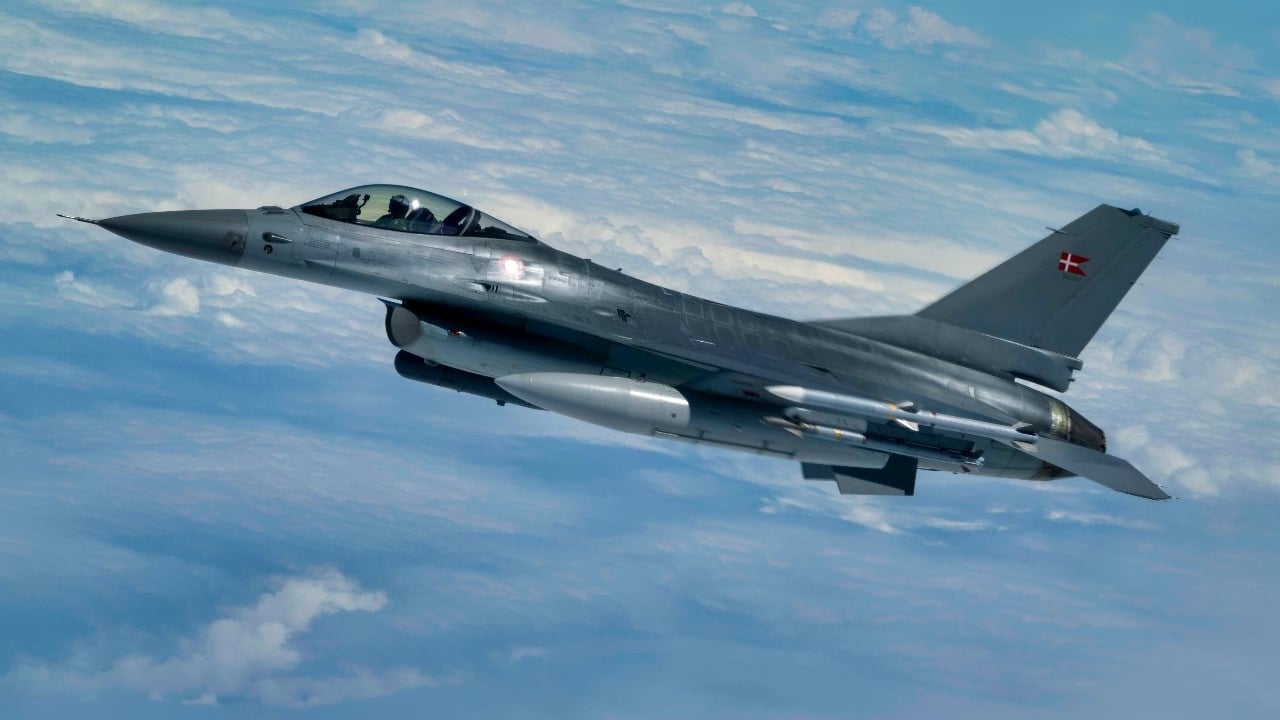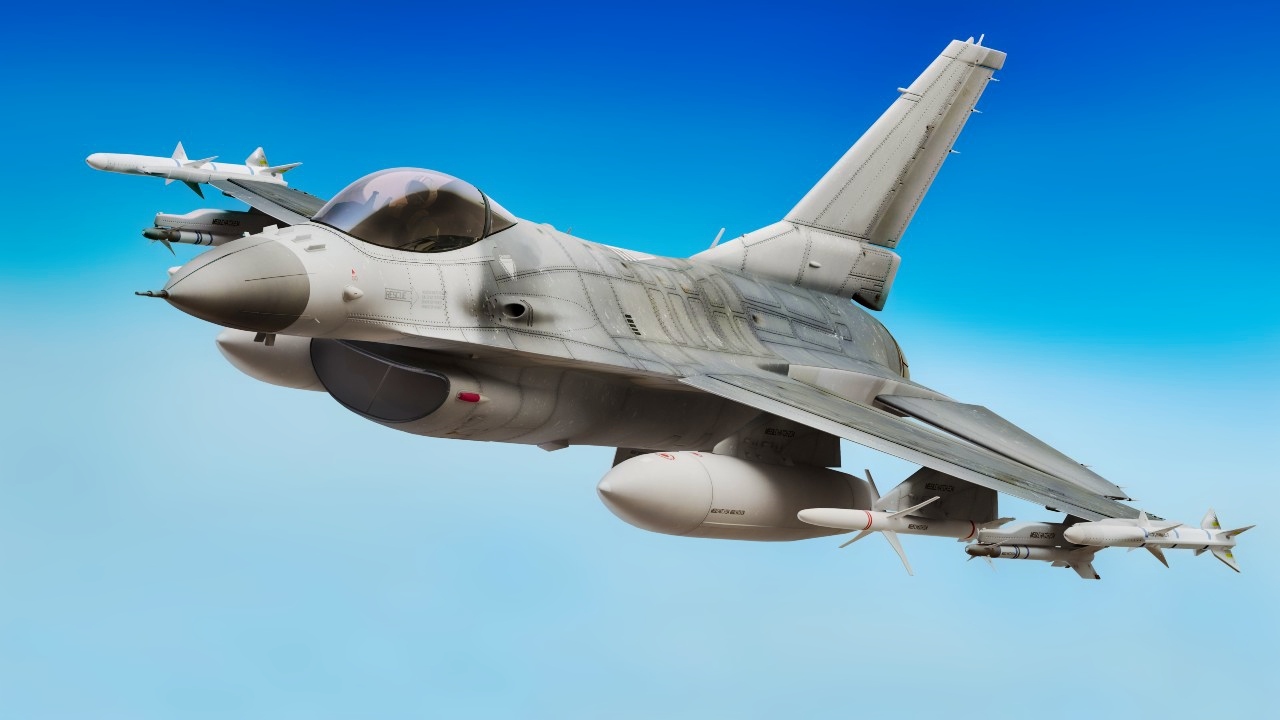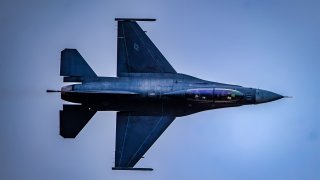F-16 Fighter Barely Dodged 6 Surface-to-Air Missiles
Desert Storm was a complex and logistically challenging operation, often overshadowed by subsequent conflicts. On January 19, 1991, the U.S. Air Force executed the largest F-16 strike in history, targeting heavily defended Baghdad.
Summary and Key Points: Desert Storm was a complex and logistically challenging operation, often overshadowed by subsequent conflicts. On January 19, 1991, the U.S. Air Force executed the largest F-16 strike in history, targeting heavily defended Baghdad.
-The mission involved 72 F-16s, supported by F-15s, F-4G Wild Weasels, and EF-111 Ravens. Despite careful planning, bad weather, exhaustion, and overwhelming Iraqi air defenses turned the operation into a harrowing experience.
-Major Emmett Tullia, callsign "Stroke 3," famously dodged six surface-to-air missiles without functioning countermeasures, showcasing the intense physical and mental strain pilots endured.
How One F-16 Pilot Survived Six Missile Attacks During Desert Storm’s Largest Airstrike
From our vantage point some 30 years later, Desert Storm seems like little more than an appetizer for future conflicts in Iraq, and as such, it tends to garner less attention than more recent (and ongoing) conflicts in the Middle East. As a result, it’s easy to forget just how massive, intricate, and logistically challenging the Coalition’s speedy victory over Saddam Hussein’s Iraqi regime really was.
While there’s no question that the Iraqi military was outclassed in every appreciable way by the massive force fielded against it, Iraq was not without serious and sizeable defenses. Iraq’s capital, Baghdad, may have been one of the most heavily defended cities on the planet when Coalition aircraft first screamed across Iraq’s border on 17 January 1991. It may be fair to say that the Coalition Force’s victory was a foregone conclusion as the Gulf War began, but the tactical and strategic domination of the Iraqi forces was not.
For months leading up to the first day of the conflict, Coalition aircraft would fly in huge groups near the Iraqi border, ensuring that when the actual campaign began, massing formations of aircraft wouldn’t serve as notice to the Iraqi military. While this is an often-ignored aspect of the conflict, this massive coordinated display of airpower was an incredible undertaking in itself, requiring close coordination between military forces and their respective nations.
On the eve of the first day of the air campaign in Iraq, General Norman Schwarzkopf’s coalition had a whopping 2,430 military aircraft at its disposal. Keen to handily defeat his opponent, the American general began the Gulf War in the skies, with five straight weeks of airstrikes and combat patrols bolstered by naval bombardments that were meant to crush Iraq’s sizeable collection of air defense assets, neuter the Iraqi Navy’s ability to deploy forces by sea, and pave the way for the ground troops and heavy armor that were soon to follow.
With more than 16,000 surface-to-air missiles (SAMs) in Iraq’s arsenal and America’s fleet of stealth F-117 Nighthawks reserved for only specific mission sets, it was largely up to American F-4s to hunt down and take out SAM sites in what are commonly referred to as “Wild Weasel” missions. The F-4G was a purpose-built iteration of the Phantom for this role, but the job was still incredibly dangerous. These stealth-less aircraft would fly into enemy airspace and identify Iraqi air defense systems as they came online, often deploying anti-radiation missiles like the AGM-88 HARM to sniff out and destroy their radar arrays.
However, sending in the Wild Weasels ahead of airstrike packages wasn’t always feasible, and even when it was, the nature of combat operations would sometimes force pilots to divert from their intended flight plan–and fly right into Iraqi defenses eagerly awaiting an opportunity to shoot down an American aircraft.
THE LARGEST F-16 STRIKE IN HISTORY
Thanks to a vast array of overlapping air defense systems and anti-aircraft artillery, supplemented by both radar-guided and optical surface-to-air missiles, the capital of Iraq had only seen airstrikes from the stealth F-117 Nighthawk in the first two days of the fighting, but on day three, the U.S. Air Force was coming in force.
A whopping 72 F-16 Fighting Falcons, each equipped with two 2,000-pound Mk 84 bombs would make up the main body of the strike force, tasked with leveling government targets and Tawaitha nuclear reactor just south of the city. Eight F-15 Eagles flew alongside the F-16s to maintain air superiority (engage any enemy fighters), eight more F-4G Wild Weasels were tasked with taking out air defense systems, and two EF-111 Raven electronic warfare aircraft would jam enemy radar while the Wild Weasels hunted them down. It would be the largest airstrike operation of the war, and the largest F-16 mission in history.
However, the challenges of deploying all these aircraft from four different installations, coordinating them in the sky, and refueling them at necessary intervals were daunting. To make matters worse, some command elements received their orders late, offering little time to prepare and practically no time for pilots to recuperate after coming off of the numerous combat sorties they’d been flying for two days prior. In other words, it was an incredibly complex and dangerous operation being executed with too little preparation by pilots who were already exhausted. Even before they climbed into their cockpits, the American pilots knew what they were about to do was the combat equivalent of trying to ice skate up a hill, but they were also supremely confident in their aircraft, their capabilities, and one another.
“We felt pretty confident it wouldn’t be as difficult as it seemed on paper,” later recounted F-16 pilot Maj. Jeffrey S. Tice. Tice would be shot down and taken prisoner before the operation was over.
THE MISSION GOES AWRY
The mission called for the fleet of F-16s to begin by engaging targets on the outskirts of the city and work their way in, which would give enemy air defense systems ample opportunity to target and engage the fighters. Unfortunately, bad weather hampering refueling efforts and some degree of confusion compromised the Wild Weasels’ portion of the mission, forcing them to leave a fair portion of their mission objectives incomplete and depart without accompanying the F-16s into the inner portion of the city.
Anti-aircraft fire coming up from the ground was so thick some pilots likened it to seeing an overcast day. The EF-111s found that there were simply too many anti-aircraft systems in the region to effectively jam them all, leaving huge swaths of the strike force vulnerable to the sizeable Iraqi missile arsenal. Before long, the F-15Cs tasked with escorting the F-16s were forced to bug out–with no enemy aircraft to fight and the sky filling with anti-aircraft fire and surface-to-air missiles, they had become little more than additional targets for the Iraqis to fire at. Soon, the decision was made to pull the entire strike force out of Bagdhad airspace.
As the fleet of F-16s flooded out of Bagdhad, Iraqi surface-to-air missiles flew in all directions, but American pilots with iron will and steel composure continued to find their targets and drop ordnance. To that point, training on how to avoid SAMs had been largely academic for Air Force pilots, learning to dodge inbound missiles just about four seconds before they’d make contact to both make them miss and ensure the aircraft was outside the approximately 33-foot blast radius when the missile detonated. The training may have been out of a book, but it wasn’t long before pilots had to put it to good use.
Contrails made a spiderweb of the sky as a whopping 27 surface-to-air missiles launched in less than three minutes. In radio recordings, you can hear Tice call out for another pilot to “break right,” but it was too late. Captain Mike Roberts’ F-16 had been hit. Not long after, another missile careened toward Tice. He executed a barrel roll and managed to avoid a direct hit but the missile exploded close enough to the aircraft to shower it with shrapnel. He was eventually able to get the F-16 back under control as backup systems came online, but the aircraft would not make it home.
“Essentially the back end of my airplane looked like an exploding cigar. There was stuff burning and I couldn’t do anything about it. The airplane was still producing thrust. I let it take me as far as it was going to go,” said Tice.
ONE F-16 DODGES 6 MISSILES
The fleet of 72 F-16s at the onset of the mission was made up of groups from two wings, with 56 hailing from 388th Tactical Fighter Wing out of Al Minhad in the United Arab Emirates and the remaining 16 from the 401st Tactical Fighter Wing out of Doha in Qatar. Among that small party from the 401st was Major Emmett Tullia, flying under the callsign “Stroke 3.”
As he made his approach, a cockpit warning went off to tell Tullia that he had been targetted by a radar-guided surface-to-air missile. In textbook fashion, he made the telephone-pole-sized missile miss with a hard turn, but noted that his chaff and flares seemed to not affect the missile’s flight. Undaunted by the close call, Tullia pressed on and was among the few F-16 pilots who were able to brave the onslaught of Iraqi defenses and find his target, deploying both 2,000-pound bombs over an oil refinery.

He turned his F-16 south to get out of the city, only to find that he’d been targetted once again. This time, three missiles were heading his way. Again, Stroke 3 took evasive action, dodging the incoming SA-3 missiles and flying straight into a lock from an even more capable SA-6 surface-to-air missile.
“Stroke 3 defending 6!” Tullia can be heard shouting over the radio while suffering under the immense G-force strain of his maneuvers. You can hear Tullia let out a groan over the radio just as the SA-6 screams by–because the pilot was sure it was going to hit him. Tullia would later report that the missile flew by at such close range, he could hear the rocket motor burning. Just then, he gets yet another alarm. There was another missile heading his way.
With so little speed and altitude left after dodging the previous missiles, Tullia was forced to go into a dive to gain escape speed, which meant flying straight into the cloud of anti-aircraft fire below. Eventually, Tullia managed to the 6th missile like he did all five previously: with nothing but expert flying. His chaff and flares failed to function throughout the entire ordeal.
THE PHYSICAL STRAIN OF EVADING A MISSILE
While taking evasive action in the movies seems a lot like taking a hard turn in your mom’s Ford Taurus, the reality of flying an F-16 at its limits is nothing of the sort. Executing hard turns in a fighter jet, or high-G maneuvers as some call them, can kill you just as readily as a missile.
“Under 9Gs, the world appears to shrink until it looks like you’re viewing it through a toilet paper roll,” F-16 turned F-35 pilot Hasard Lee explained to Sandboxx News.

“Blood is being pulled out of your head towards your legs and arms, resulting in the loss of peripheral vision. If too much blood is pulled out, you’ll pass out, resulting in incapacitation for around half a minute. Due to the speeds we fly, there’s a high probability the jet will crash before you wake up,” Lee added.
After executing these maneuvers, pilots will feel the repercussions for days, or even the rest of their lives.
“After high-G flights, my arms and legs will have what appears to be chickenpox: blood has pooled in my extremities and caused the blood vessels to rupture. It’s similar to a bruise and usually dissipates within a few days. The long-term effects of high-Gs can result in neck and back issues – most pilots deal with some level of general pain due to Gs,” Lee said.
In footage recorded from the nose of his aircraft, you can not only see the hair-raising combat environment these pilots found themselves in, but you can also hear the bravery, professionalism, and stress in their voices as they worked to find their targets, stay alive, and look out for one another. In what is perhaps the most hair-raising portion of the video, you can hear the physical stress and exhaustion overtaking Tullia’s voice as he calls out that he is once again attempting to avoid getting hit.

To make matters that much worse for Tullia, his chaff and flares, tools designed to distract incoming infrared and radar-guided missiles, were not functioning. He would only discover the malfunction after landing. Not only did Tullia defeat six surface-to-air missiles, he did it without any chaff or flares.
UNDERSTANDING THE FOOTAGE
To anyone who hasn’t spent years obsessing over military aviation, the ten-minute video above may be hard to follow. These pilots are also so supremely professional that, at times, the life-or-death struggle unfolding within is coupled with brief statements in practically conversational tones. Such is the confidence, training, and capability level found in Uncle Sam’s combat aviators.
So, let’s break down what happens in this video in terms we can all appreciate, to better understand these incredible circumstances.
What you see on the screen
This footage was recorded from Major Emmett Tullia’s F-16, flying under the callsign, “Stroke 3.” He receives his first warning of an inbound missile shortly after the 3:00 minute mark.
On the top left-hand side of the screen as the video starts, you can see how many Gs the aircraft is currently pulling, with calibrated airspeed just below it. Below that, you can see the maximum Gs the aircraft has pulled thus far in the flight.
The right-hand side shows altitude, with altitude above the ground (radar altimeter) below that.
- At approximately 3:16, you can hear Tullia under duress, calling out, “Stroke 3 defending SA-2” as the aircraft can be seen banking left. The SA-2 Guideline is the NATO reporting name for the Soviet S-75 Dvina high-altitude air defense system, which leverages radar to guide its missiles to their targets.
- At approximately 3:44 you can hear one of the pilots say “jettisoned, egressing.” Tullia and some other pilots jettisoned their external fuel tanks to reduce the weight of the aircraft and increase their ability to maneuver. This was a risky move, as without those external tanks, Tullia couldn’t be sure he’d have enough fuel to make it back.
- By 3:50, Tulia’s Stroke 3 has already managed to make two inbound surface-to-air missiles miss.
- At 4:36 you can hear another pilot shout “Stroke 3 come on! Stroke 3 check right, break right! Stroke 3 break right!” as he sees the third missile fired at Tullia’s aircraft.
- At 4:52 you can hear pilots say, “someone got hit,” and “Stroke 4 got hit” as another F-16 is hit by a missile. After, you can hear pilots with increasing stress in their voices calling out, “Stroke 4 status?” to check on their downed friend, but by then, he is unable to respond.
- At 5:22 you can see the aircraft making aggressive turns to try to avoid being hit by an incoming SAM.
- At 5:32 you can hear a pilot say, “second one, break” telling Stroke 3 to evade as another missile closes in. After Tullia dodges it, you can hear someone say, “that’s two” meaning he dodged both inbound missiles. At that point, Tullia has already dodged four SAMs.
- At 5:58 you can hear a pilot call out, “Another SAM launch, another SAM launch same location!”
- At 6:02 you can see the contrails from multiple SAMs that had been recently launched.
- At 6:14 you can hear Tullia call out, “Oh shiiiii…” as a SAM comes very close to hitting his aircraft.
- At 6:20 you can hear labored breathing as Tullia calls out, “Stroke 3 defending” under heavy Gs. The G indicator suggests he’s pulled more than 6 Gs.
- At 6:38 you can hear pilots asking aloud, “Stroke 3 are you still there?”
- At 6:53, Tullia responds, “Stroke 3 is headed south.”
- At 6:59 you see the aircraft go inverted as Tullia once again calls out, “Stroke 3 defending 6” as yet another SAM flies his way. That “6” indicated an SA-6, or Soviet 2K12 “Kub” — which is a more capable weapon system than the SA-2’s fired earlier. His breathing is becoming increasingly labored by this time. He’s now pushing 6.5 Gs.
- Shortly after that, Stroke 3 is able to make it out of the fight
About the Author
Alex Hollings is a writer, dad, and Marine veteran.
This article was first published by Sandboxx News.
All images are Creative Commons and/or Shutterstock.


